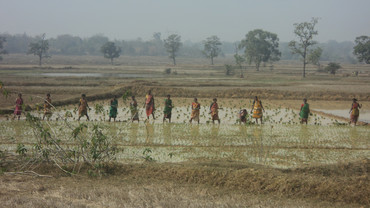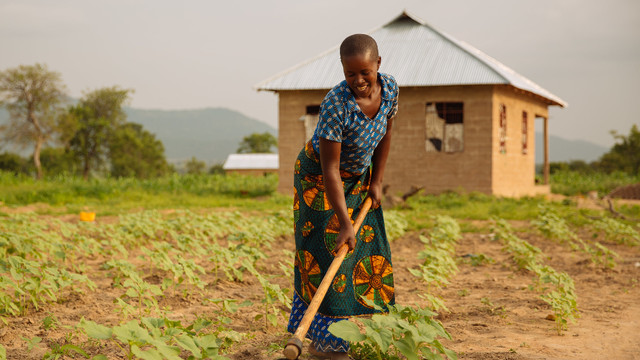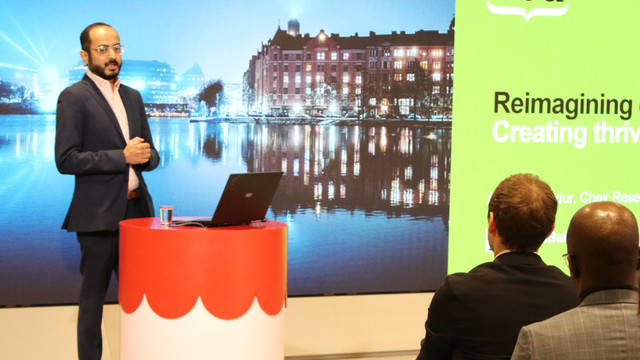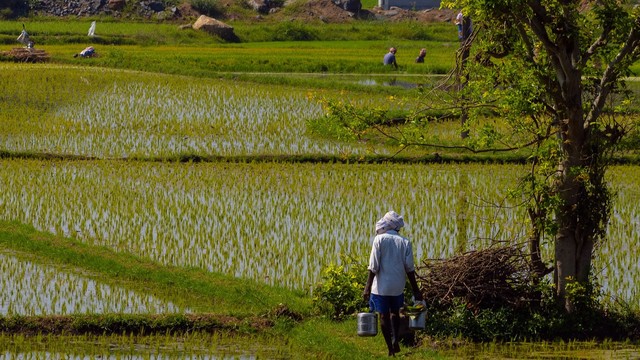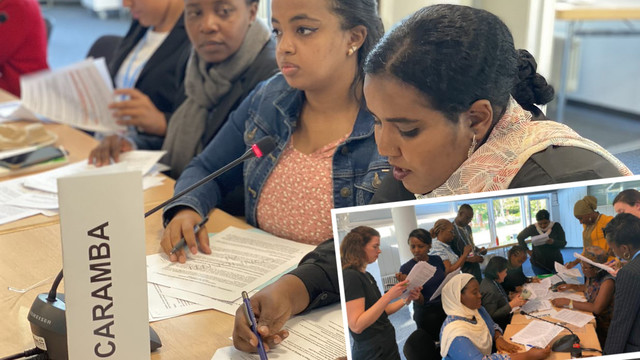
A group of women support one another to learn how to use a tool for climate resilience (Photo: H&K Communications)
A pioneering online tool co-developed by IIED to help Indian farmers access and share local climate data and plan for resilience has proved so successful that a new, more widely-useable version has been launched in India.
The new user-friendly Universal Climate Resilience Information System and Planning (U-CRISP) tool – or app – was launched by the government of Madhya Pradesh, IIED and the Madhya Pradesh Council of Science and Technology (MPCST) in September 2023.
U-CRISP provides communities with local climate data and helps them plan resilience measures. The tools fill a vital gap: millions of farmers across India rely on rainfed agriculture. In recent years, communities have seen their crops destroyed by erratic rains, droughts and powerful heatwaves. When their crops fail, many adults are forced to leave home to seek work in cities. Climate change brings food insecurity, debts and poverty.
Tools like U-CRISP can enable rural communities to access and use data that will be critical for long-term efforts to conserve and manage water in an increasingly drought-hit region.
Building on proven impact
U-CRISP builds on the CRISP-M tool, a similar app created by IIED and MPCST in 2021, that provides farmers with climate data to support inclusive village-level resilience planning.
CRISP-M links with India's Mahatma Gandhi National Rural Employment Guarantee Scheme (MGNREGS), the world's largest public works-based social protection programme. MGNREGS provides a safety net for rural households by offering 100 days of employment in exchange for labour on public works. IIED has championed the use of social protection programmes like MGNREGS for climate protection.
CRISP-M has three core components:
- An early warning system for droughts to help officials make timely decisions
- An asset planning module that uses geographic information system (GIS) data to deliver data on land use, topography, geology and groundwater levels, and
- A community-sourced asset management module that allows communities to record and monitor local assets
The tool stores information to help rural communities plan for the increasingly frequent and intense droughts affecting Madhya Pradesh – a state where more than half the population is engaged in agriculture and related sectors and climate anxiety hangs heavily in the air.
Brajlal Baribal, 27-year-old farmer, Pratapgadh villageMy father used to tell me stories of farmers committing suicide, unable to bear the brunt of extreme weather conditions. The information available on CRISP-M has not only helped me take better care of my crops but has also given me hope that things can change for the better if we all work together.
The tool quickly gained wide recognition, and Indian Minister for Rural Development and Panchyati Raj, Giriraj Singh, announced that CRISP-M would be scaled out across seven Indian states: Bihar, Jharkhand, Uttar Pradesh, Madhya Pradesh, Chhattisgarh, Odisha, and Rajasthan.
CRISP-M's impact spurred demand for a generic version that could be used by any stakeholder, anywhere, for inclusive climate-resilient planning. Using a design process that included feedback from existing users, IIED and MPCST co-developed this more generic 'universal' version of the tool for use across India and beyond.
IIED's 'tech plus people' approach
Both the CRISP tools are designed to be accessed via computer or smartphone and allow local people to easily record and monitor information about local assets and use it for community-based planning. However, the project partners knew that designing technology was not enough: the delivery model is key.
The CRISP tools are built around a volunteer-led community engagement process, which sees people volunteer as 'climate saathis' ('friends' in Hindi). They receive training on how to build awareness of climate risks and resources and how to undertake community-level participatory planning for climate resilience. The roll-out also featured a strong push to involve poor and marginalised groups, including women farmers and Scheduled Castes and Tribes.
This ‘tech plus people’ approach is characteristic of IIED's work, which aims to provide people at the grassroots with the tools and resources they need to take community-level climate action.
Profile: becoming a climate ‘friend’
Rukmani Bai lives in the remote village of Barela in Madhya Pradesh, and since her husband became ill, she has been responsible for the family of nine children. Rukmani started farming her husband's land, but when rains damaged her crops, she had no access to government assistance.
A climate saathi helped her learn how to use the CRISP-M tool to gain access to MGNREGS benefits and plan water conservation measures. She now passes that learning on to a local self-help group of 25 women and advocates for climate action at community meetings.
Rukmani Bai, farmer, Barela villageWhen I go to village meetings, people look at me with respect and awe because I have information that they don’t have. But I don’t just use the information to help myself. I share it so that others can benefit from it.
Welcomed and well-resourced
Both CRISP tools were supported by the Indian Ministry of Rural Development and the UK’s Foreign Commonwealth and Development Office under the Infrastructure for Climate Resilient Growth programme.
The U-CRISP launch was widely reported in India’s press, and it signalled long-term goals, with the opening of a Resource Centre for Climate-Resilient Planning at MPCST. The centre will build awareness of U-CRISP and provide technical support for users. Demand seems assured: the launch attracted around 300 people from government departments and ministries, NGOs and other stakeholders.
Supporting community resilience around the globe
Ritu Bharadwaj, IIED principal researcher, says the tools have global potential.
“Having near-real-time, local climate information is hugely valuable for rural communities who are often the most vulnerable to climate shocks. It allows them to plan projects from the bottom up, based on their needs and unique circumstances, and mitigate climate-related risks in advance,” she said.
“As global warming worsens, humanity must get ahead of it using apps like U-CRISP and early warning systems to improve resilience.
“The success we’ve had in integrating U-CRISP into India’s existing social protection system has created opportunities to scale up its use for environmental, forestry and water planning across the country and globally.”




